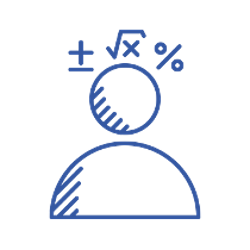How can I help my students with quantitative problem solving?

Quick tips from the Faculty Teaching Institute about how to support students with quantitative problem solving.
Normalize the use of group work for problem solving, making it a regular part of your in-class instruction, so that students get used to supporting each other and articulating their ideas about how to solve problems.
Emphasize that solving problems in groups helps students. This helps them successfully solve problems that they might otherwise struggle to do on their own, boosting students’ confidence and skills simultaneously.
Have students work at the board (or whiteboard) when possible so every group member can see and contribute, and you can see their progress. It also normalizes brainstorming, making mistakes, and trying again.
Model good problem solving. When you solve problems in a lecture, be explicit about which strategies you are using. Demonstrate and normalize trying multiple approaches and representations. It can be helpful to show how some approaches may not lead to a solution and that making and detecting mistakes is a normal part of problem solving.
Scaffold problem solving. Break problems into “steps” that each correspond to a decision students must make while working toward a solution – such as sketching the situation or selecting an equation to use. Each decision highlights a particular conceptual, reasoning, or mathematical difficulty students commonly experience. It’s best if this is done as a class activity, engaging students in discussion at each step and providing meaningful feedback on their progress.
Reward problem solving on homework and exams. Give credit for a good problem-solving process even if a student doesn't get the “right” answer. Don’t give credit if students give only their answers without explaining how they got there.
Additional practices:
- Ask students to reflect on their problem-solving process. To encourage reflection, ask students to write a narrative, indicating any strategies that they used, on submitted coursework. Students can also explain their process to another group.
- Choose problems that have real-life contexts and applications. This boosts students’ interests, motivation, and perception of the relevance of physics.
- Invite students to write their own problems. This inspires students’ curiosity, creativity, and engagement with the discipline of physics at a deep level.
This Expert Recommendation is based in part on L. Strubble, Problem solving Strategies for Estimation in Physics and Astronomy (2018).
This material is based upon work supported by the National Science Foundation under grants DUE-2141678, 2141745, 2141769, 2141795, and 2142045. Any opinions, findings, and conclusions or recommendations expressed in this material are those of the author(s) and do not necessarily reflect the views of the National Science Foundation.
 Add a Comment
Add a Comment


